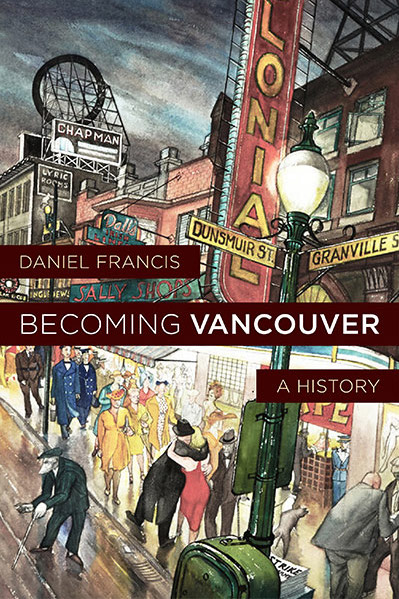
Becoming Vancouver: A History
Review By John Belec
January 10, 2023
BC Studies no. 216 Winter 2022/23 | p. 143-144
Daniel Francis is an accomplished Vancouver-based author of books written in the genre of popular history. In Canada, the patron saint of such work is Pierre Berton. Thus, it is fitting that Francis was awarded the Governor General’s Award for Popular Media, aka the Pierre Berton Award, in 2017. His ouvre is vast and much of it informs the writing of Becoming Vancouver: A History. This includes earlier books on the sex trade, prohibition, the red-scare of 1918-19 and a biography of Louis Taylor, Vancouver’s longest serving mayor. Francis has also produced two books that interrogate facets of settler-Indigenous relations in Canada.
In Becoming Vancouver, Daniel Francis has written the definitive story of Vancouver. Were this story to become a scripted Netflix series, the lead would be played by a dashing character that struggles with dissociative personality disorder. The affliction appeared early in childhood and manifests in contradictory impulses. “One impulse wants to protect its location in order to build an affordable, green, ‘livable’ city. Another wants to leverage its location to make the city every more attractive to the forces of global capitalism.” (3) This split personality also functions as a persistent fault line, according to Francis, and is a central theme in his book.
Becoming Vancouver is organized chronologically and is character-driven. Fortunately for the author, Vancouver offers an abundant supply of characters from which to draw, some with familiar names, such as Gassy Jack, Cornelius Van Horne, Joe Fortes, Gerry McGeer, Tom Campbell and Arthur Erickson. However most of the cast will likely be new to the reader. Francis begins the book with August Jack Khahtsahlano who was born in 1877 in the village of Sen-ákw, located at the mouth of False Creek. The forced relocation of Khahtsahlano to the Capilano Reserve in North Vancouver establishes a context: Vancouver is built on stolen land: “mainstream Vancouver…removed the Indigenous people who originally lived within the city’s borders and pretty much erased them from its memory.” (223).
The book is organized into eight chapters with each covering approximately twenty years of history, beginning with the arrival of Vancouver Island Spar, Lumber and Saw Mill Company in Burrard Inlet in 1865 and ending with COVID 19 in 2020. Each chapter is characterized with a theme that helps to contextualize the numerous places, names, dates and events. Historic photographs are also plentiful and work well to supplement the text.
A shortcoming is a lack of reference maps. With the exception of a small-scale map of Vancouver circa 1886 that identifies early neighbourhoods and land holdings, the reader has little to help with locating geographical references, chiefly roads, that are used extensively in the book. For non-residents this results in a certain disconnect with the subject matter. The solution, of course, is to keep a city map handy, paper or online. Even better would be to supplement Becoming Vancouver with a historical atlas of Vancouver. Hayes (2005) and Macdonald (1992) would serve well in this regard.
Ultimately, Becoming Vancouver tells a compelling story that draws on a wealth of archival, academic and popular resource material. As a deep dive into the psyche of the city, it could just as well be titled “understanding” Vancouver.
REFERENCES
Hayes, Derek. 2005. Historical Atlas of Vancouver and the Lower Fraser Valley. Vancouver: Douglas and McIntyre.
Macdonald, Bruce. 1992. Vancouver: A Visual History. Vancouver: Talon Books
Publication Information
Francis, Daniel. Becoming Vancouver: A History. Madeira Park, BC: Harbour Publishing, 2021. 272 pp. $36.95 paper.
